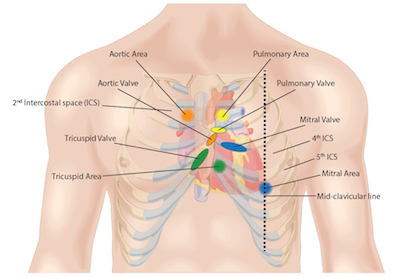心脏考试 II: 听诊
资料来源: Suneel Dhand,MD,参加医师,内科,贝斯以色列女执事医疗中心
熟练使用听诊器听心音和区分正常和异常心音的能力是任何医生必备的重要技能。听诊器在胸口上的安放正确对应于心脏瓣膜关闭的声音。心有两种主要的声音: S1 和 S2。第一心音 (S1) 发生作为二尖瓣和三尖瓣 (房室瓣) 关闭后血液进入心室。这表示收缩期的开始。第二心音 (S2) 时发生主动脉瓣和肺动脉瓣 (半月瓣) 关闭后血液有左心室进入收缩期末尾的全身和肺循环系统。传统上,声音被称为"滑配音"。
使用横膈膜和贝尔的听诊器胸件部分执行心脏听诊。横膈膜最常用和最适合高频率的声音 (如 S1 和 S2) 和二尖瓣和主动脉瓣狭窄的杂音。横膈膜应紧贴胸壁。贝尔最佳传输低频率的声音 (如 S3 和 S4) 和二尖瓣狭窄的杂音。钟应适用和轻微的压力。
1.病人在 30-45 度位置。
2.确保被检查的部位被暴露,并且永远不会通过这件礼服听诊。
3.将听诊器放在定义的解剖标志 (图 1)。一个好的经验法则,找到第二肋间空间是定位角的路易斯 (manubriosternal 联合),在这个水平。用你的手指来查找其他肋间空间描述触诊横向或纵向。

图 1。听诊表面的地标。
- 主动脉区
- 隔膜泵的听诊器置于 2nd肋间,右胸骨边缘。这是为主动脉瓣的解剖标志。
- 听第二心音,代表主动脉瓣关闭至少 5 秒。
- 肺动脉瓣区
- 隔膜泵的听诊器置于 2nd肋间,左胸骨边缘。这是为肺动脉瓣的解剖标志。
- 听第二心音,代表肺动脉瓣关闭至少 5 秒。
- 三尖瓣区
- 隔膜泵的听诊器置于 4th -5th肋间,胸骨左边。这是为三尖瓣瓣膜的解剖标志。
- 听第一心音表示三尖瓣关闭至少 5 秒。
- 二尖瓣区
- 隔膜泵的听诊器置于th 5 肋间,锁骨中线 (心尖相同区域)。这是为二尖瓣瓣膜的解剖标志。
- 听第一心音,代表二尖瓣关闭至少 5 秒。
4.其他听诊区:
主要动脉与肺听诊也提供心血管系统功能的基本的信息。
- 与隔膜泵的在基部的肺部听诊器听诊。侦听任何水泡或裂纹,液体在肺 (肺水肿),心衰的标志指示。
- 钟的颈总动脉在听诊器听诊。通常情况下,可能听说是目前从主动脉瓣的杂音。此外,听诊这里的杂音 (嗖嗖声音产生的湍流的血流量),这是颈动脉狭窄的标志。
- 听诊腹部血管杂音在肾动脉和股动脉,以评估为周围血管疾病。
心脏听诊仍然是基本的技能之一任何临床医生到大师,并提供了许多心脏异常重要的诊断线索。学习听诊的正确方法是必要的以便区分正常和病理。所有的心脏地区必须被别人听诊结构化和有条理的方式。物理的结果的解释应当就心动周期,并应指出强度、 持续时间、 球场和每个声音的时机。至关重要的是,要记住解剖标志在哪里听诊器应放在病人的胸部,并总是检查患者在安静的环境。它是重要的是听至少 5 秒,而病人的呼吸通常情况下,为了避免物理考试-不允许足够的时间来听听心音过程中常见的错误之一。医生必须熟悉他们的听诊器和横膈膜和贝尔参与期间心脏听诊。
跳至...
此集合中的视频:

Now Playing
心脏考试 II: 听诊
Physical Examinations I
138.9K Views

物理考试的一般方法
Physical Examinations I
115.1K Views

观察和检查
Physical Examinations I
92.9K Views

触诊
Physical Examinations I
82.4K Views

打击乐
Physical Examinations I
99.2K Views

听诊
Physical Examinations I
60.0K Views

病人的服装物理考试期间的适当调整
Physical Examinations I
82.8K Views

血压测量
Physical Examinations I
106.8K Views

测量生命体征
Physical Examinations I
113.5K Views

呼吸道考试 i: 检查和触诊
Physical Examinations I
155.6K Views

呼吸道考试 II: 打击乐和听诊
Physical Examinations I
211.2K Views

心脏考试 i: 检查和触诊
Physical Examinations I
175.0K Views

心脏的考试 III: 异常心音
Physical Examinations I
91.1K Views

外围的血管考试
Physical Examinations I
67.6K Views

用连续波多普勒的外围血管考试
Physical Examinations I
38.3K Views
版权所属 © 2025 MyJoVE 公司版权所有,本公司不涉及任何医疗业务和医疗服务。